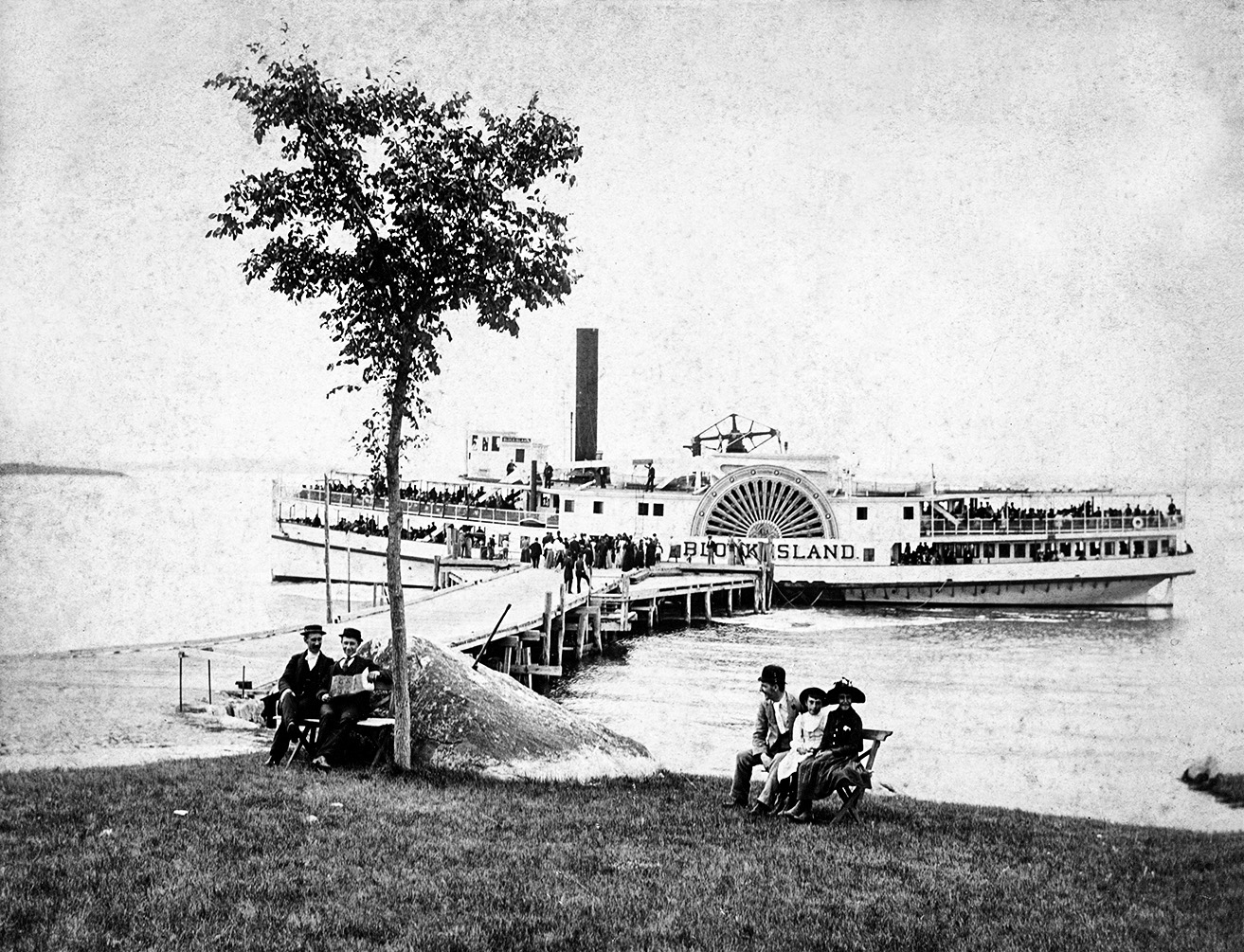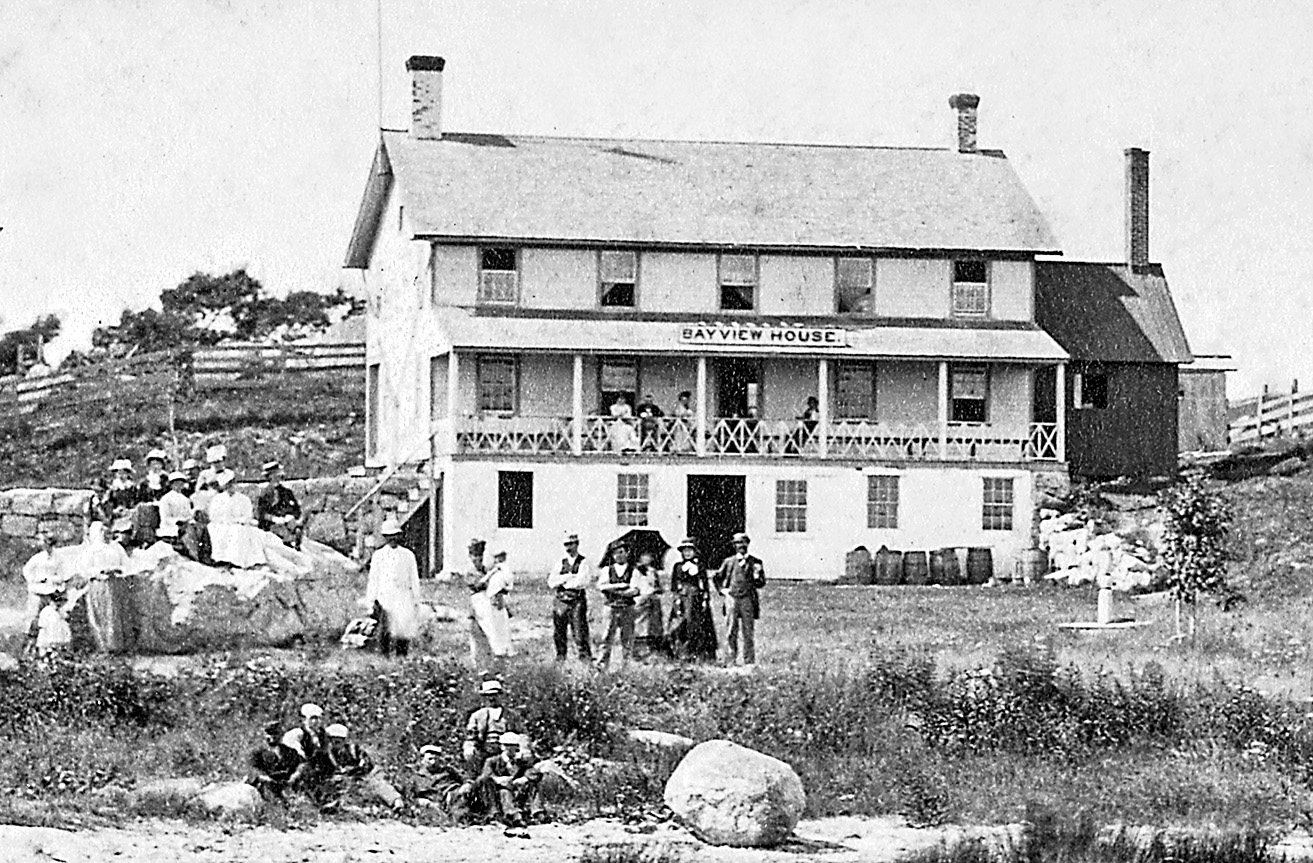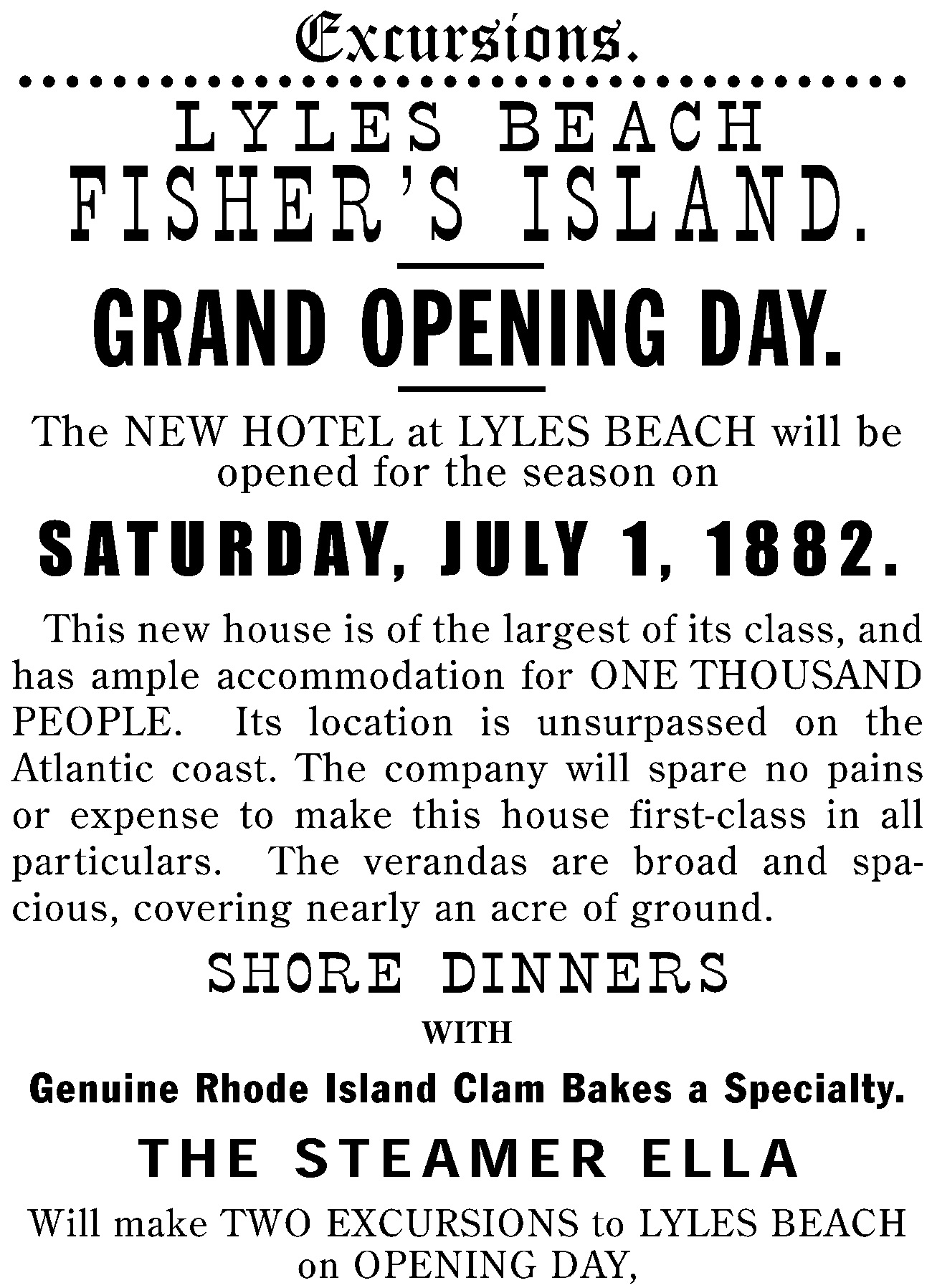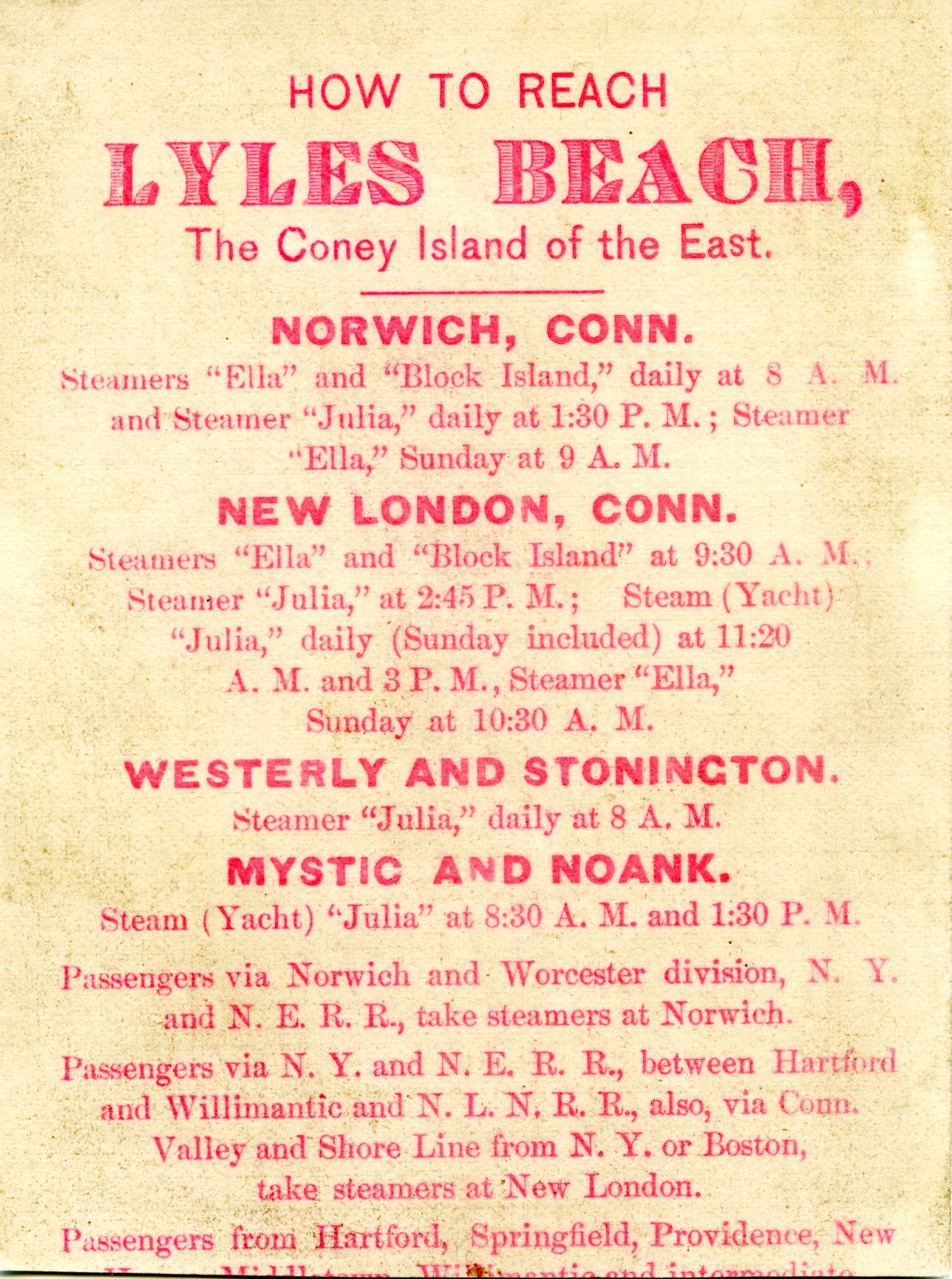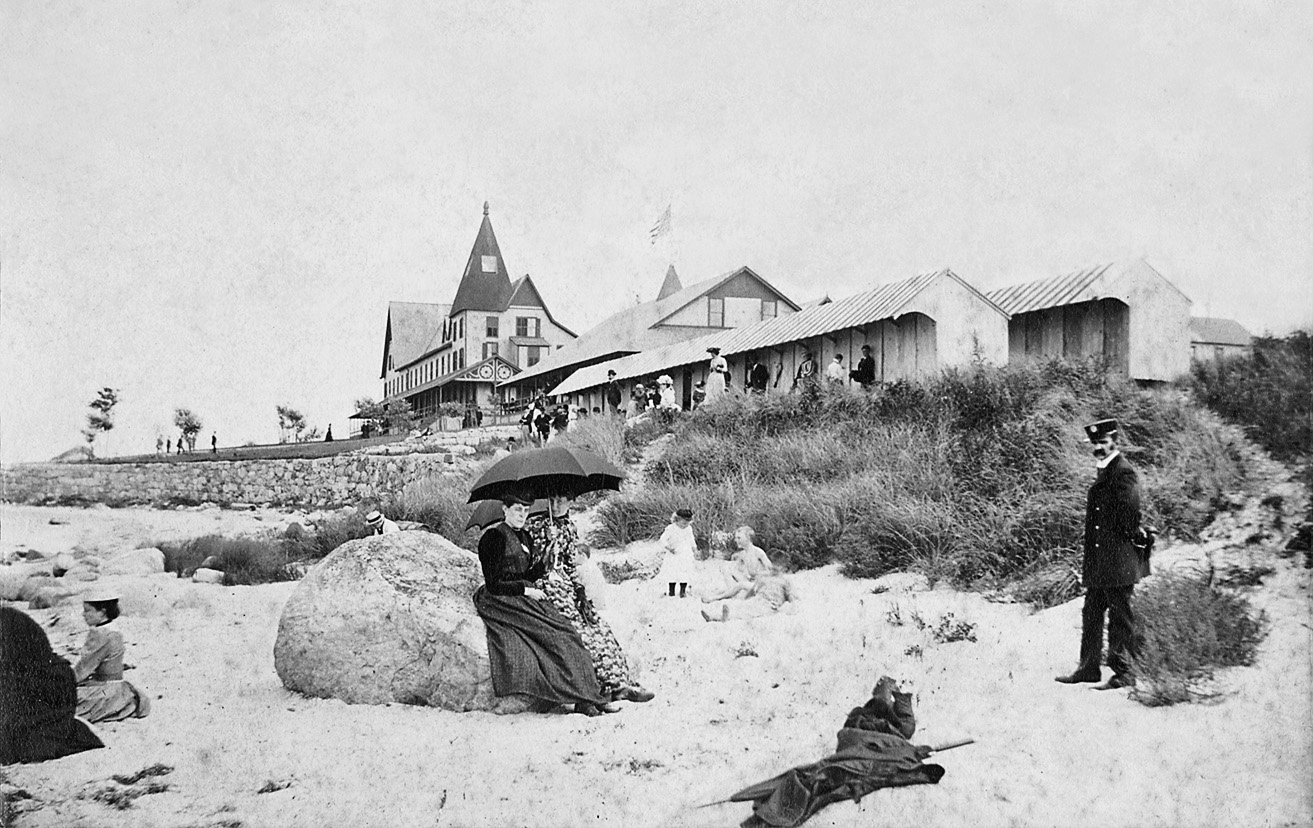Island History
The Lyles Beach Hotel: The Center of Fishers Island’s Brief Flirtation with Tourism
by Pierce Rafferty
Since the first settlement of Fishers Island by John Winthrop in the 1640s, Fishers Island has undergone two main phases of development. For more than 220 years, under Winthrop family ownership, it functioned predominantly as a working stock farm and dairy with supplemental brickmaking and hay export. In 1863, retired merchant Robert Ralston Fox purchased the entire island from the last of the Winthrop owners. Surprising those who expected more varied economic development, he continued the Island’s traditional use as a private stock farm and dairy. Following Fox’s unexpected death in 1871, the Fox estate entertained a variety of proposals from outside developers. When these plans failed to materialize, the estate initiated its own plan to create a seaside community on the west end of Fishers Island. Land lot sales to the public commenced in December 1876. These sales—notably, the first since initial settlement in the 17th century—initiated the second phase of Fishers Island’s development: its transformation into a seaside resort.
In the late 1870s and 1880s, a new community quickly took shape on Fishers Island. New businesses included the Mansion House, formerly the Fox family residence, which opened as an upscale boutique hotel in the summer of 1877. Small steamers of the Pequot and Ocean Transit line running out of New London brought patrons back and forth to this new destination during the summer season, docking at a location near today’s Yacht Club. Nearby, a rough and tumble boarding house named the Bay View House opened circa 1879, fronting West Harbor on or near the site of today’s Reid Barn. Retired whalers working as carpenters lived there along-side other lodgers. The Bay View, capacity 20, burned to the ground in May 1884.
In July 1882, a new hotel, backed by Norwich business interests, opened on Fishers Island’s north shore just west of to-day’s “Three Sisters” Cottages. Operating as the “Lyles Beach Hotel” or simply “Lyles Beach,” it was named for James H. Lyles, the trustee of the Fox Estate who was then handling all land sales on Fishers Island. The Lyles Beach catered primarily to “day excursionists,” better known today as “day trippers.” Beginning in 1882, excursionists came to our shores in throngs during the summer season (late June to mid-September) carried by some of the biggest passenger ferries in our region, including the SS Ella, the SS Block Island, and the SS Julia. These large paddlewheel steamers landed at the new Lyles Beach dock, completed by the T.A. Scott Co. of New London in May 1882 and measuring 180 feet in length. Over the course of a sunny Saturday one might see as many as 750 or even 1,000 passengers disembarking at Lyles Beach from several steamers.
Who were these day trippers? In addition to individuals and small groups (single families, groups of friends), newspaper accounts reveal that many Lyles Beach patrons came in larger, organized groups, especially social, fraternal, religious, political, and business associations; sports clubs of every stripe; as well as those organized around school and military reunions, political conventions, and work forces from specific factories.
Lyles Beach promised a fun-filled day with clam bakes and Rhode Island-style shore dinners (serving capacity was 1,000 people), drinking, and dancing. Advertisements highlighted the full range of inducements and attractions, including a merry-go-round, an arcade with photograph and shooting galleries, a well-appointed billiard room, a “bowling room” with three large alleys and a small one for children, a spacious dance hall, a brass and string orchestra, and a roller-skating rink.
Sports activities included tub and catboat races, single and double scull races, baseball games, and a rifle range “better than the military’s.” Yachts and sailboats with experienced captains always stood at the ready, along with small boats for fishing and rowing. (Notably, the first incarnation of the Fishers Island Yacht Club participated in at least one cat-rigged boat race with mainland yacht clubs starting from Lyles Beach in 1886). Those seeking local adventure on firmer ground could take horse-drawn omnibus trips to all parts of the island.
The Hotel dining room could accommodate 600 people, but there were only about 40 guest rooms. In any case, few patrons of Lyles Beach stayed overnight. As darkness fell, the vast majority boarded a return steamer bound for the shore towns of Connecticut and Rhode Island—primarily New London, Norwich, Groton, and Watch Hill.
As already noted, drinking was a primary activity and attraction, made all the more popular because sections of south- eastern Connecticut were then “dry.” An 1895 temperance book included the detail that “[Lyles Beach] was the only public resort hereabout where one could get all the beer he wanted on a Sunday, hence it was well patronized. Fishers Island was in New York State, and rather out of the reach of search warrant officers.” (Quote from “The Way Out: A Solution of the Temperance Crisis,” by Hugh Montgomery.)
Alcohol played a leading role in a horrific story about an interracial brawl that occurred at Lyles Beach on August 2, 1888. This event generated bold headlines in newspapers up and down the east coast. The Boston Globe covered the story on August 3rd under the banner headline “RAZORS AGAINST CLUBS – Furious Fight Between Bricklayers and Negro Waiters at the Steamer Landing at Lyle’s Beach.” The body of that story stated:
“The steamer Block Island this evening brings particulars of a savage fight this afternoon between four Norwich colored men and a dozen white men. The colored men are employed as waiters at the Lyle’s Beach Hotel, while the whites are employed at the brickyard across the bay. One of the brickyard gang, who was under the influence of liquor, picked a row with one of the waiters. The latter resented the drunken man’s insult and bystanders interfered. This was about noon. When the steamer Block Island, on her return trip, made fast at the dock at 4:30 to take on a Grand Army excursion from this city [Norwich], the trouble broke out again. There were fully 500 Norwich people congregated on the dock, among whom was the brickyard gang, all more or less intoxicated.
“While the people were waiting for the gang plank to be put out the four colored waiters came on the dock. The same white man who began the trouble took up the thread of the battle. He caught the waiter and began to punish him. The other three waiters fell upon the brickyard gang, and the dozen or more companions of the latter took a hand. Hundreds of men, women and children became panic stricken and sought safety. Several frightened youths jumped off the dock, but suffered no injury.
“Fierce and fast waged the battle on the pier. The negroes drew razors and the whites plied their heavy clubs. One white man was cut across the forehead in a wicked manner. Pat Ryan was slashed from shoulder to hip, his abdomen being almost laid open.”
The Globe’s account also detailed the lesser injuries of the other brickyard workers, adding that two of the “colored” men were arrested at the dock in Norwich when the SS Block Island landed. Three of the four “negroes” were ultimately charged with assault in the second degree and sent to a county jail on Long Island to await the actions of the grand jury. No account of their sentencing has been found. The white brick- yard workers faced no known consequences for their actions. By 1886, the Lyles Beach ran into fiscal problems and went into receivership. Cornelius McNamara and S.E. Marx of Norwich, two of the main creditors, purchased the Lyles Beach in 1887 for $8,751. Marx and McNamara didn’t proceed to transform the hotel into a more exclusive venue as some rumors suggested they would. Other new, powerful businesspeople on Fishers Island, however, were interested in remaking the entire resort on Fishers Island, hoping to radically derail the pro-excursionist policies of Lyles Beach.
Familiar with Fishers Island from visitations beginning in the mid-1880s, two prominent banking brothers, Edmund M. and Walton Ferguson, liked what they saw. In June of 1889, the Fergusons made an outright purchase from the Fox estate of 9/10ths of Fishers Island. They bought the whole of the Island, excepting 101 parcels that had been sold at the west end between 1876 and 1889.
The Ferguson brothers’ plan for development was ambitious: transform Fishers Island from a day excursion destination into a resort that catered to an exclusive clientele on a seasonal basis. Their development plan involved major changes to the Island’s hotels—but stumbling blocks lay in their path. One major impediment was the Lyles Beach Hotel itself. The institution wasn’t part of their 1889 purchase from the Fox estate, as it was privately owned. The Fergusons had no chance of creating an elite resort if day trippers were still crowding our shores by the steamer load at Lyles Beach.
After wooing the owners, the brothers succeeded in purchasing the hotel in 1891 for $10,000. They quickly shut it down for a complete makeover. The former Lyles Beach re-opened in 1892 as the more refined Munnatawket Hotel. Because all major docks and landings lay under their control, the Fergusons were able to ban all excursion steamers from landing on Fishers Island.
Lest there be any doubt about the intentions or origins of the new anti-excursionist policy, the following proclamation was issued in an E.M. & W. Ferguson promotional brochure circa 1893:
“The denizens upon the Island are protected from an influx of the excursion element by the fact that all landings are owned by the Messrs. Ferguson. In order further to protect the Island against all possible annoyances the proprietors have purchased from the State of New York a strip of land running entirely around the Island from the shore outward.”
Thus ended the brief tourist period on Fishers Island, one largely contained to Lyles Beach and lasting only for one short decade: 1882 to 1891. In the ensuing century and a third, “day trippers” from the mainland have lacked a welcoming beach-head or destination on Fishers Island. There is, of course, the Pequot Inn, founded in 1902 as the Canonicus House, but its central purpose has never been to serve as a magnet to the outside world. In our history, Lyles Beach, which hyperbolically billed itself as the “Coney Island of the East,” stands alone in that regard, entirely comfortable in its short-lived role as a full-throated and whole-hearted attraction. With its shuttering, Fishers Island’s message to all day-visitors seeking fun on our shores—and to the outside world in general—became crystal clear:

